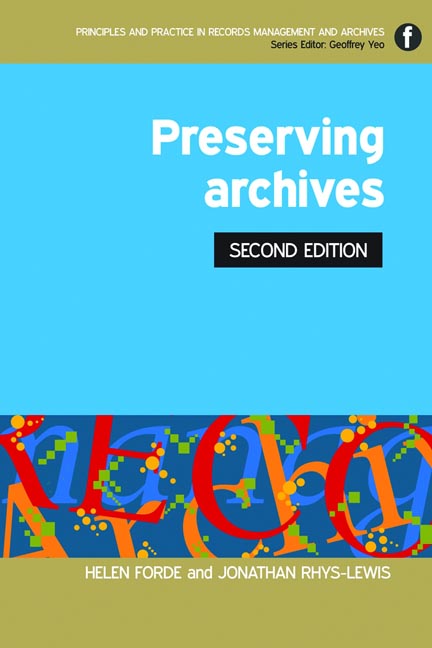Book contents
- Frontmatter
- Contents
- Introduction to the series Geoffrey Yeo
- Preface to the Second Edition
- Acknowledgements
- 1 Introducing archive preservation
- 2 Understanding archival materials and their characteristics
- 3 Managing digital preservation
- 4 Archive buildings and their characteristics
- 5 Safeguarding the building and its contents
- 6 Managing archival storage
- 7 Managing risks and avoiding disaster
- 8 Creating and using surrogates
- 9 Moving the records
- 10 Exhibiting archives
- 11 Handling the records
- 12 Managing a pest control programme
- 13 Training and the use of volunteers
- 14 Putting preservation into practice
- Appendices
- Bibliography
- British and international standards relating to archive preservation
- Index
3 - Managing digital preservation
Published online by Cambridge University Press: 09 June 2018
- Frontmatter
- Contents
- Introduction to the series Geoffrey Yeo
- Preface to the Second Edition
- Acknowledgements
- 1 Introducing archive preservation
- 2 Understanding archival materials and their characteristics
- 3 Managing digital preservation
- 4 Archive buildings and their characteristics
- 5 Safeguarding the building and its contents
- 6 Managing archival storage
- 7 Managing risks and avoiding disaster
- 8 Creating and using surrogates
- 9 Moving the records
- 10 Exhibiting archives
- 11 Handling the records
- 12 Managing a pest control programme
- 13 Training and the use of volunteers
- 14 Putting preservation into practice
- Appendices
- Bibliography
- British and international standards relating to archive preservation
- Index
Summary
Introduction
To the archivist the need to preserve selected digital information of long-term value is fairly self-evident, but to many of those involved in the creation of data the importance of strategies for preservation is not so obvious. Assumptions are made about the longevity of digital information which are quite unfounded, even when the evidence of the potential fragility of the medium is there for all to see. Archivists and records managers have to develop new approaches and engage earlier to ensure that serious loss of information does not take place in the context of rapidly rising use of the technology. Digital preservation is a much more stable technique than it was even ten years ago, but the discussions and debates surrounding it need to be translated into active strategies, adopted by all organizations with a concern for the future of their documentation.
This chapter looks at:
• why digital preservation is important
• why it is perceived as difficult
• what decisions are needed to ensure that the appropriate digital material is preserved over time
• who should be involved
• how to start and maintain the process.
This chapter does not deal with the technical aspects of digital preservation; advice on this is best sought from the national archives of the relevant country, such as The National Archives (TNA) or organizations such as Digital Preservation Coalition (DPC) in the UK, and in the USA, the National Digital Stewardship Alliance or the impressive guidance and developmental work carried out by the Library of Congress. The DPC is a consortium of library, archive and research organizations, brought together to pool ideas, promote best practice and publish research on digital preservation issues.
Why is digital preservation management important?
Digital preservation (the act of ensuring enduring access to electronic material) is rarely undertaken by the same person who deals with the more traditional forms of archive preservation. Increasingly, however, it is essential for all archivists to understand some of the management principles and strategies adopted to achieve it and the contribution that different professions can make to this. The most important point is that building preservation into any digital project at the outset is much easier, more efficient and vastly cheaper than attempting to preserve, or re-create the material at a later stage.
- Type
- Chapter
- Information
- Preserving Archives , pp. 25 - 40Publisher: FacetPrint publication year: 2013

